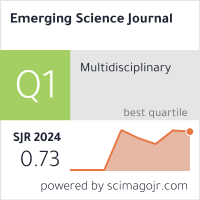SY-MIS Project: Biomedical Design of Endo-Robotic and Laparoscopic Training System for Surgery on the Earth and Space
Downloads
Doi:10.28991/ESJ-2024-08-02-01
Full Text:PDF
Downloads
Goh, E. Z., & Ali, T. (2022). Robotic surgery: an evolution in practice. Journal of Surgical Protocols and Research Methodologies, 2022(1). doi:10.1093/jsprm/snac003.
Takacs, A., Jordan, S., Nagy, D. A., Tar, J. K., Rudas, I. J., & Haidegger, T. (2015). Surgical robotics”Born in space. 2015 IEEE 10th Jubilee International Symposium on Applied Computational Intelligence and Informatics, Timisoara, Romania. doi:10.1109/saci.2015.7208264.
D'Ettorre, C., Mariani, A., Stilli, A., Rodriguez Y Baena, F., Valdastri, P., Deguet, A., Kazanzides, P., Taylor, R. H., Fischer, G. S., Dimaio, S. P., Menciassi, A., & Stoyanov, D. (2021). Accelerating Surgical Robotics Research: A Review of 10 Years with the da Vinci Research Kit. IEEE Robotics and Automation Magazine, 28(4), 56–78. doi:10.1109/MRA.2021.3101646.
Bresler, L., Perez, M., Hubert, J., Henry, J. P., & Perrenot, C. (2020). Residency training in robotic surgery: The role of simulation. Journal of Visceral Surgery, 157(3), S123–S129. doi:10.1016/j.jviscsurg.2020.03.006.
Wang, X., Zheng, Z., & Chi, P. (2021). Surgeon Technical Skills, a Potential Confounder in Clinical Trials. JAMA Surgery, 156(5), 500. doi.10.1001/jamasurg.2020.6677.
Chahal, B., Aydın, A., Amin, M. S. A., Ong, K., Khan, A., Khan, M. S., Ahmed, K., & Dasgupta, P. (2022). Transfer of open and laparoscopic skills to robotic surgery: a systematic review. Journal of Robotic Surgery, 17(4), 1207–1225. doi:10.1007/s11701-022-01492-9.
Beullens, J., Rethans, J. J., Goedhuys, J., & Buntinx, F. (1997). The use of standardized patients in research in general practice. Family Practice, 14(1), 58–62. doi:10.1093/fampra/14.1.58.
Stillman, P. L., & Swanson, D. B. (1987). Ensuring the Clinical Competence of Medical School Graduates through Standardized Patients. Archives of Internal Medicine, 147(6), 1049–1052. doi:10.1001/archinte.1987.00370060045009.
Agency for Healthcare Research and Quality. (2001). Making health care safe: a critical analysis of patient safety practices. The American Journal of Cosmetic Surgery, 18(4), 215-224. doi:10.1177/074880680101800405.
Seymour, N. E., Gallagher, A. G., Roman, S. A., O'Brien, M. K., Bansal, V. K., Andersen, D. K., & Satava, R. M. (2002). Virtual Reality Training Improves Operating Room Performance. Annals of Surgery, 236(4), 458–464. doi:10.1097/00000658-200210000-00008.
Ahlberg, G., Enochsson, L., Gallagher, A. G., Hedman, L., Hogman, C., McClusky, D. A., Ramel, S., Smith, C. D., & Arvidsson, D. (2007). Proficiency-based virtual reality training significantly reduces the error rate for residents during their first 10 laparoscopic cholecystectomies. The American journal of surgery, 193(6), 797–804. doi:10.1016/j.amjsurg.2006.06.050.
Spiliotis, A. E., Spiliotis, P. M., & Palios, I. M. (2020). Transferability of Simulation-Based Training in Laparoscopic Surgeries: A Systematic Review. Minimally Invasive Surgery, 2020. doi:10.1155/2020/5879485.
Haidegger, T., & Benyo, Z. (2008). Surgical robotic support for long duration space missions. Acta Astronautica, 63(7–10), 996–1005. doi:10.1016/j.actaastro.2008.01.005.
Li, Y., Hannaford, B., & Rosen, J. (2019). The raven open surgical robotic platforms: A review and prospect. Acta Polytechnica Hungarica, 16(8), 9–27. doi:10.12700/APH.16.8.2019.8.2.
Miller, K. H., Sutton, E., & Pantalos, G. (2022). Hierarchical Task Analysis Reimagined as a Planning Tool for Surgery During Exploration Space Flight. Surgical Innovation, 29(5), 616–624. doi:10.1177/15533506211053210.
Haidegger, T., Sándor, J., & Benyó, Z. (2011). Surgery in space: The future of robotic telesurgery. Surgical Endoscopy, 25(3), 681–690. doi:10.1007/s00464-010-1243-3.
Ball, C. G., Kirkpatrick, A. W., Williams, D. R., Jones, J. A., Polk, J. D., Vanderploeg, J. M., Talamini, M. A., Campbell, M. R., & Broderick, T. J. (2012). Prophylactic surgery prior to extended-duration space flight: Is the benefit worth the risk? Canadian Journal of Surgery, 55(2), 125–131. doi:10.1503/cjs.024610.
Panesar, S. S., & Ashkan, K. (2018). Surgery in space. British Journal of Surgery, 105(10), 1234–1243. doi:10.1002/bjs.10908.
Cornejo-Aguilar, J. A., Cornejo, J., Vargas, M., & Sebastian, R. (2019). The revolution of robotic surgery in latin america and the future implementation in the healthcare system of Peru. Revista De La Facultad De Medicina Humana, 19(1), 5. doi:10.25176/rfmh.v19.n1.1800.
Hennessey, I. A. M., & Hewett, P. (2013). Construct, concurrent, and content validity of the EOSIM laparoscopic simulator. Journal of Laparoendoscopic and Advanced Surgical Techniques, 23(10), 855–860. doi:10.1089/lap.2013.0229.
De Guzman, C. J. P., Chua, A. Y., Chu, T. S., & Secco, E. L. (2023). Evolutionary Algorithm-Based Energy-Aware Path Planning with a Quadrotor for Warehouse Inventory Management. HighTech and Innovation Journal, 4(4), 829-837. doi:10.28991/HIJ-2023-04-04-012.
ASMA. (2023). Space Medicine Residencies. Aerospace Medical Association (ASMA), Alexandria, United States. Available online: https://www.amsro.org/residencies (accessed on March 2024).
Jänsch, J., & Birkhofer, H. (2006). The development of the guideline VDI 2221 - The change of direction. 9th International Design Conference, DESIGN 2006, 15–18 May, 2006, Dubrovnik, Croatia.
Cornejo, J., Cornejo-Aguilar, J. A., & Palomares, R. (2019). Biomedik Surgeon: Surgical Robotic System for Training and Simulation by Medical Students in Peru. 2019 International Conference on Control of Dynamical and Aerospace Systems (XPOTRON). doi:10.1109/XPOTRON.2019.8705717.
Cornejo, J., Perales-Villarroel, J. P., Sebastian, R., & Cornejo-Aguilar, J. A. (2020). Conceptual Design of Space Biosurgeon for Robotic Surgery and Aerospace Medicine. IEEE ANDESCON, Quito, Ecuador. doi:10.1109/andescon50619.2020.9272122.
Cornejo, J., Cornejo-Aguilar, J. A., Sebastian, R., Perales, P., Gonzalez, C., Vargas, M., & Elli, E. F. (2021). Mechanical Design of a Novel Surgical Laparoscopic Simulator for Telemedicine Assistance and Physician Training during Aerospace Applications. 2021 IEEE 3rd Eurasia Conference on Biomedical Engineering, Healthcare and Sustainability (ECBIOS), Tainan, Taiwan. doi:10.1109/ecbios51820.2021.9510753.
Cornejo, J., Barrera, S., Herrera Ruiz, C. A., Gutierrez, F., Casasnovas, M. O., Kot, L., Solis, M. A., Larenas, R., Castro-Nieny, F., Arbulú Saavedra, M. R., Rodríguez Serrezuela, R., Muñoz Londoño, Y., Serna, A., Ortega-Aranda, D., Aranda-Miramontes, S., Chang, I., Cardona, M., Carrasquilla-Batista, A., Palomares, R., ... L'Huillier, E. A. (2023). Industrial, Collaborative and Mobile Robotics in Latin America: Review of Mechatronic Technologies for Advanced Automation. Emerging Science Journal, 7(4), 1430–1458. doi:10.28991/esj-2023-07-04-025.
Cornejo, J., Cornejo-Aguilar, J. A., Gonzalez, C., & Sebastian, R. (2021). Mechanical and Kinematic Design of Surgical Mini Robotic Manipulator used into SP-LAP Multi-DOF Platform for Training and Simulation. IEEE XXVIII International Conference on Electronics, Electrical Engineering and Computing, Lima, Peru. doi:10.1109/intercon52678.2021.9532965.
Dombre, E., & Khalil, W. (2007). Modeling, Performance Analysis and Control of Robot Manipulators. Wiley-ISTE, London, United Kingdom. doi:10.1002/9780470612286.
Corke, P. (2014). Denavit-Hartenberg notation for common robots. PeterCorke: Brisbane, Australia.
ISO 13485:2016. (2016). Medical devices: Quality management systems, Requirements for regulatory purposes. International Organization for Standardization (ISO), Geneva, Switzerland.
Food and Drug Administration Center for Devices and Radiological Health. (1997). Design control guidance for medical device manufacturers. Food and Drug Administration Center for Devices and Radiological Health, New Hampshire, United States.
ASTM. (2016). Medical device standards and implant standards - standards products - standards & publications - products & services. ASTM International, Pennsylvania, United States. Available online: https://www.astm.org/products-services/standards-and-publications/standards/medical-device-standards-and-implant-standards.html (accessed on March 2024).
Ahlstrom, V., & Longo, K. (2003). Human Factors Design Standard (HF-STD-001). Atlantic City International Airport, Federal Aviation Administration William J. Hughes Technical Center, U.S. Department of Transportation, Washington, United States.
Graessler, I., & Hentze, J. (2020). The new V-Model of VDI 2206 and its validation das Neue V-Modell der VDI 2206 und seine Validierung. At-Automatisierungstechnik, 68(5), 312–324. doi:10.1515/auto-2020-0015.
Rivera, M. V., Cornejo, J., Huallpayunca, K., Diaz, A. B., Ortiz-Benique, Z. N., Reina, A. D., Jamanca Lino, G., & Ticllacuri, V. (2020). Human space medicine: Physiological performance and countermeasures to improve astronaut health. Magazine of the Faculty of Human Medicine, 20(2), 131–142. doi:10.25176/rfmh.v20i2.2920.
Krittanawong, C., Singh, N. K., Scheuring, R. A., Urquieta, E., Bershad, E. M., Macaulay, T. R., Kaplin, S., Dunn, C., Kry, S. F., Russomano, T., Shepanek, M., Stowe, R. P., Kirkpatrick, A. W., Broderick, T. J., Sibonga, J. D., Lee, A. G., & Crucian, B. E. (2022). Human Health during Space Travel: State-of-the-Art Review. Cells, 12(1), 40. doi:10.3390/cells12010040.
Hayden, J. A., Pantalos, G. M., Burgess, J. E., & Antaki, J. F. (2013). A hermetically sealed, fluid-filled surgical enclosure for microgravity. Aviation Space and Environmental Medicine, 84(12), 1298–1303. doi:10.3357/ASEM.3751.2013.
Pantalone, D. (2023). Surgery in the Next Space Missions. Life, 13(7), 1477. doi:10.3390/life13071477.
Cornejo, J., Cornejo-Aguilar, J. A., Vargas, M., Helguero, C. G., Milanezi de Andrade, R., Torres-Montoya, S., Asensio-Salazar, J., Rivero Calle, A., Martínez Santos, J., Damon, A., Quiñones-Hinojosa, A., Quintero-Consuegra, M. D., Umaña, J. P., Gallo-Bernal, S., Briceño, M., Tripodi, P., Sebastian, R., Perales-Villarroel, P., De la Cruz-Ku, G., McKenzie, T., Arruarana, V. S., Ji, J., Zuluaga, L., Haehn, D. A., Paoli, A., Villa, J. C., Martinez, R., Gonzalez, C., Grossmann, R. J., Escalona, G., Cinelli, I., & Russomano, T. (2022). Anatomical Engineering and 3D Printing for Surgery and Medical Devices: International Review and Future Exponential Innovations. BioMed Research International, 2022, 6797745. doi:10.1155/2022/6797745.
Drudi, L., Ball, C. G., Kirkpatrick, A. W., Saary, J., & Marlene Grenon, S. (2012). Surgery in space: Where are we at now? Acta Astronautica, 79, 61–66. doi:10.1016/j.actaastro.2012.04.014.
Rajput, S. (2021). A review of space surgery - What have we achieved, current challenges, and future prospects. Acta Astronautica, 188, 18–24. doi:10.1016/j.actaastro.2021.07.012.
Pinsolle, V., Martin, D., De Coninck, L., Techoueyres, P., & Vaí¯da, P. (2005). Microsurgery in microgravity is possible. Microsurgery, 25(2), 152–154. doi:10.1002/micr.20089.
Campbell, M. R., Billica, R. D., Jennings, R., & Johnston, S. (1996). Laparoscopic surgery in weightlessness. Surgical Endoscopy, 10(2), 111–117. doi:10.1007/BF00188354.
Campbell, M. R., Williams, D. R., Buckey, J. C., & Kirkpatrick, A. W. (2005). Animal surgery during spaceflight on the neurolab shuttle mission. Aviation Space and Environmental Medicine, 76(6), 589–593.
Reina, A. D., Cornejo, J., Galvis-Forero, S., Guzman, E., & Oliva-Hernandez, R. (2021). Animals and Technology in Space: A Perspective from Aerospace Engineering to Veterinary Medicine. IEEE International Conference on Health, Instrumentation & Measurement, and Natural Sciences (InHeNce), Medan, Indonesia. doi:10.1109/inhence52833.2021.9537247.
Kirkpatrick, A. W., McKee, J. L., Tien, H., LaPorta, A. J., Lavell, K., Leslie, T., King, D. R., McBeth, P. B., Brien, S., Roberts, D. J., Franciose, R., Wong, J., McAlistair, V., Bouchard, D., & Ball, C. G. (2017). Damage control surgery in weightlessness: A comparative study of simulated torso hemorrhage control comparing terrestrial and weightless conditions. Journal of Trauma and Acute Care Surgery, 82(2), 392–399. doi:10.1097/TA.0000000000001310.
European Space Agency (ESA). (2023). Parabolic flights. European Space Agency (ESA), Paris, France. Available online: https://www.esa.int/Science_Exploration/Human_and_Robotic_Exploration/Research/Parabolic_flights (accessed on March 2024)
Thirsk, R., Williams, D., & Anvari, M. (2007). NEEMO 7 undersea mission. Acta Astronautica, 60(4-7), 512–517. doi:10.1016/j.actaastro.2006.09.015.
Hasenstein, K. H., Van Loon, J. J. W. A., & Beysens, D. (2015). Clinostats and other rotating systems”design, function, and limitations. Generation and applications of extra-terrestrial environments on earth, 14, 147-156. doi:10.1201/9781003338277-17.
Aizawa, K., Kanazawa, M., Haraguchi, D., & Tadano, K. (2020). Surgical robotic arm with pneumatic semi-active joints for load reduction on tool-insertion port. Sensors and Materials, 32(3), 1015–1026. doi:10.18494/SAM.2020.2713.
Jaspers, J., Den Boer, K., Sjoerdsma, W., Bruijn, M., & Grimbergen, C. (2000). Design and feasibility of PASSIST, a passive instrument positioner. Journal of Laparoendoscopic & Advanced Surgical Techniques, 10(6), 331-335. doi:10.1089/lap.2000.10.331.
Walczak, D. A., Piotrowski, P., Jč™drzejczyk, A., PaweŠ‚czak, D., & Pasieka, Z. (2014). A laparoscopic simulator – maybe it is worth making it yourself. Videosurgery and Other Miniinvasive Techniques, 3, 380–386. doi:10.5114/wiitm.2014.44139.
Prince, S. W., Kang, C., Simonelli, J., Lee, Y. H., Gerber, M. J., Lim, C., Chu, K., Dutson, E. P., & Tsao, T. C. (2020). A robotic system for telementoring and training in laparoscopic surgery. The International Journal of Medical Robotics and Computer Assisted Surgery, 16(2), 2040. doi:10.1002/rcs.2040.
Xiao, D., Albayrak, A., Jakimowicz, J. J., & Goossens, R. H. M. (2013). A newly designed portable ergonomic laparoscopic skills Ergo-Lap simulator. Minimally Invasive Therapy & Allied Technologies, 22(6), 337–345. doi:10.3109/13645706.2013.821997.
Armijo, P. R., Pagkratis, S., Boilesen, E., Tanner, T., & Oleynikov, D. (2018). Growth in robotic-assisted procedures is from conversion of laparoscopic procedures and not from open surgeons' conversion: a study of trends and costs. Surgical Endoscopy, 32(4), 2106–2113. doi:10.1007/s00464-017-5908-z.
Kenney, P. A., Wszolek, M. F., Gould, J. J., Libertino, J. A., & Moinzadeh, A. (2009). Face, Content, and Construct Validity of dV-Trainer, a Novel Virtual Reality Simulator for Robotic Surgery. Urology, 73(6), 1288–1292. doi:10.1016/j.urology.2008.12.044.
Schreuder, H. W. R., Persson, J. E. U., Wolswijk, R. G. H., Ihse, I., Schijven, M. P., & Verheijen, R. H. M. (2014). Validation of a novel virtual reality simulator for robotic surgery. The Scientific World Journal, 2014. doi:10.1155/2014/507076.
Yang, K., Zhen, H., Hubert, N., Perez, M., Wang, X. H., & Hubert, J. (2017). From dV-Trainer to Real Robotic Console: The Limitations of Robotic Skill Training. Journal of Surgical Education, 74(6), 1074–1080. doi:10.1016/j.jsurg.2017.03.006.
Chen, R., Rodrigues Armijo, P., Krause, C., Siu, K.-C., & Oleynikov, D. (2019). A comprehensive review of robotic surgery curriculum and training for residents, fellows, and postgraduate surgical education. Surgical Endoscopy, 34(1), 361–367. doi:10.1007/s00464-019-06775-1.
Kesavadas, T., Stegemann, A., Sathyaseelan, G., Chowriappa, A., Srimathveeravalli, G., Seixas-Mikelus, S., Chandrasekhar, R., Wilding, G., & Guru, K. (2011). Validation of Robotic Surgery Simulator (RoSS). Studies in Health Technology and Informatics, 163, 274–276. doi:10.3233/978-1-60750-706-2-274.
Stegemann, A. P., Ahmed, K., Syed, J. R., Rehman, S., Ghani, K., Autorino, R., Sharif, M., Rao, A., Shi, Y., Wilding, G. E., Hassett, J. M., Chowriappa, A., Kesavadas, T., Peabody, J. O., Menon, M., Kaouk, J., & Guru, K. A. (2013). Fundamental Skills of Robotic Surgery: A Multi-institutional Randomized Controlled Trial for Validation of a Simulation-based Curriculum. Urology, 81(4), 767–774. doi:10.1016/j.urology.2012.12.033.
Alshuaibi, M., Perrenot, C., Hubert, J., & Perez, M. (2020). Concurrent, face, content, and construct validity of the RobotiX Mentor simulator for robotic basic skills. The International Journal of Medical Robotics and Computer Assisted Surgery, 16(3), 2100. doi:10.1002/rcs.2100.
Kneebone, R. L. (2009). Practice, rehearsal, and performance: An approach for simulation-based surgical and procedure training. Jama, 302(12), 1336–1338. doi:10.1001/jama.2009.1392.
Finnegan, K. T., Meraney, A. M., Staff, I., & Shichman, S. J. (2012). Da Vinci skills simulator construct validation study: Correlation of prior robotic experience with overall score and time score simulator performance. Urology, 80(2), 330–336. doi:10.1016/j.urology.2012.02.059.
Long, A. S., Almeida, M. N., Chong, L., & Prsic, A. (2023). Live Virtual Surgery and Virtual Reality in Surgery: Potential Applications in Hand Surgery Education. The Journal of Hand Surgery, 48(5), 499–505. doi:10.1016/j.jhsa.2023.01.004.
Chadebecq, F., Lovat, L. B., & Stoyanov, D. (2023). Artificial intelligence and automation in endoscopy and surgery. Nature Reviews Gastroenterology & Hepatology, 20(3), 171–182. doi:10.1038/s41575-022-00701-y.
Rivas, H., Robles, I., Riquelme, F., Vivanco, M., Jiménez, J., Marinkovic, B., & Uribe, M. (2018). Magnetic Surgery: Results from First Prospective Clinical Trial in 50 Patients. Annals of Surgery, 267(1), 88–93. doi:10.1097/SLA.0000000000002045.
Wady, H., & Docimo, S. (2023). Natural Orifice Translumenal Endoscopic Surgery (NOTESTM). In M. Kroh, S. Docimo Jr, S. E. Djouzi, A. Shada, & K. M. Reavis (Eds.), The SAGES Manual Operating through the Endoscope, Second Edition (pp. 909–927). Springer International Publishing. doi:10.1007/978-3-031-21044-0_44.
Costantino, A., Sampieri, C., Pirola, F., De Virgilio, A., & Kim, S. (2022). Development of machine learning models for the prediction of positive surgical margins in Transoral Robotic Surgery (TORS). Head & Neck, 45(3), 675–684. Portico. doi:10.1002/hed.27283.
Burstein, M. D., & Fung, E. C. (2023). Endoscopic Training”Surgeon and GI Paradigms. The SAGES Manual Operating Through the Endoscope, Springer, Cham, Switzerland. doi:10.1007/978-3-031-21044-0_5.
Wang, T. N., Underhill, J. M., Renshaw, S. K., & Haisley, K. R. (2023). Optimal Timing of Fundamentals of Endoscopic Surgery (FES) Testing in General Surgery Residency: Early Is Better. Journal of Gastrointestinal Surgery, 27(12), 2893–2898. doi:10.1007/s11605-023-05727-4.
Alfa-Wali, M., & Antoniou, A. (2011). Eco-friendly laparoscopic home trainer. Simulation in Healthcare, 6(3), 176–179. doi:10.1097/SIH.0b013e318208549b.
Wong, J., Bhattacharya, G., Vance, S. J., Bistolarides, P., & Merchant, A. M. (2013). Construction and Validation of a Low-Cost Laparoscopic Simulator for Surgical Education. Journal of Surgical Education, 70(4), 443–450. doi:10.1016/j.jsurg.2013.02.004.
Hung, A. J., Zehnder, P., Patil, M. B., Cai, J., Ng, C. K., Aron, M., Gill, I. S., & Desai, M. M. (2011). Face, content and construct validity of a novel robotic surgery simulator. Journal of Urology, 186(3), 1019–1025. doi:10.1016/j.juro.2011.04.064.
- This work (including HTML and PDF Files) is licensed under a Creative Commons Attribution 4.0 International License.




















